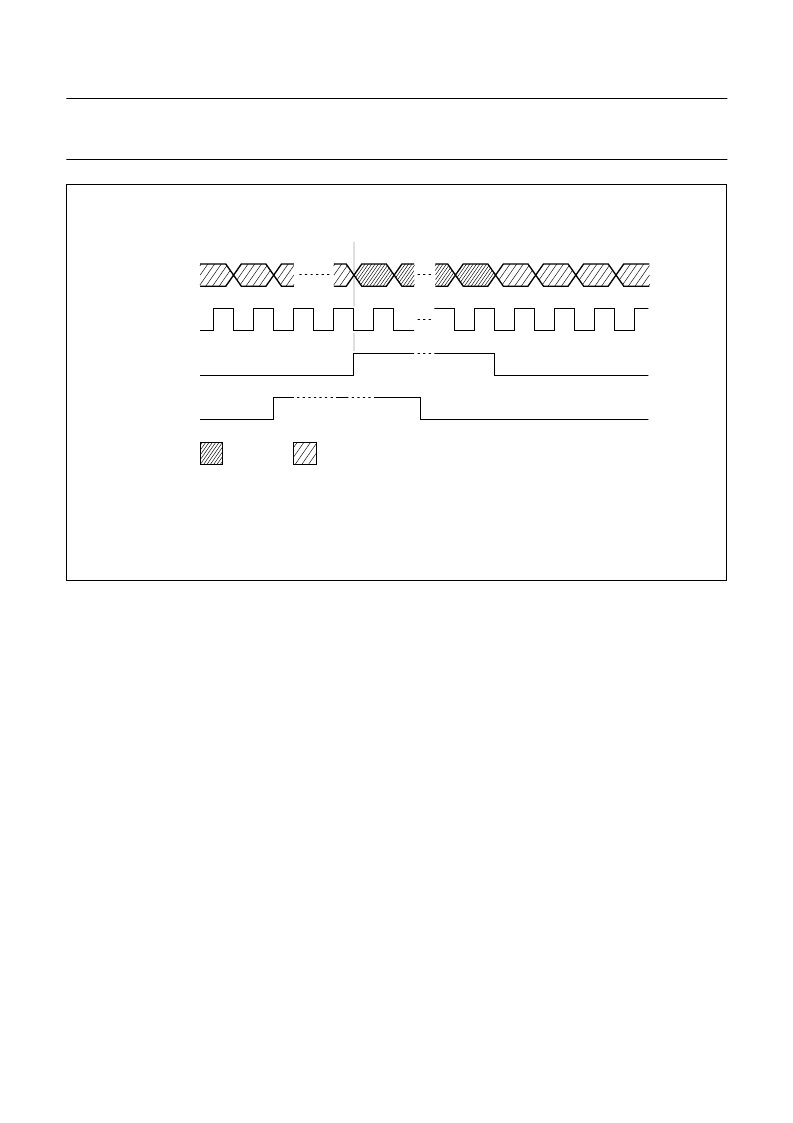- 您現(xiàn)在的位置:買賣IC網(wǎng) > PDF目錄372108 > SAA2501H (NXP SEMICONDUCTORS) Digital Audio Broadcast DAB decoder PDF資料下載
參數(shù)資料
| 型號(hào): | SAA2501H |
| 廠商: | NXP SEMICONDUCTORS |
| 元件分類: | 消費(fèi)家電 |
| 英文描述: | Digital Audio Broadcast DAB decoder |
| 中文描述: | SPECIALTY CONSUMER CIRCUIT, PQFP44 |
| 封裝: | 10 X 10 MM, 1.75 MM HEIGHT, PLASTIC, SOT-307-2, QFP-44 |
| 文件頁(yè)數(shù): | 17/52頁(yè) |
| 文件大小: | 206K |
| 代理商: | SAA2501H |
第1頁(yè)第2頁(yè)第3頁(yè)第4頁(yè)第5頁(yè)第6頁(yè)第7頁(yè)第8頁(yè)第9頁(yè)第10頁(yè)第11頁(yè)第12頁(yè)第13頁(yè)第14頁(yè)第15頁(yè)第16頁(yè)當(dāng)前第17頁(yè)第18頁(yè)第19頁(yè)第20頁(yè)第21頁(yè)第22頁(yè)第23頁(yè)第24頁(yè)第25頁(yè)第26頁(yè)第27頁(yè)第28頁(yè)第29頁(yè)第30頁(yè)第31頁(yè)第32頁(yè)第33頁(yè)第34頁(yè)第35頁(yè)第36頁(yè)第37頁(yè)第38頁(yè)第39頁(yè)第40頁(yè)第41頁(yè)第42頁(yè)第43頁(yè)第44頁(yè)第45頁(yè)第46頁(yè)第47頁(yè)第48頁(yè)第49頁(yè)第50頁(yè)第51頁(yè)第52頁(yè)

January 1995
17
Philips Semiconductors
Preliminary specification
Digital Audio Broadcast (DAB) decoder
SAA2501
Fig.9 Input data serial transfer format (slave input).
CDSSY indicates frame start at next valid data.
handbook, full pagewidth
CDSWA
CDSCL
CDSSY
CDS
frame start
MGB497
valid data
invalid data
Whether frame sync signal CDSSY is present or not must
be selected with L3 settings flags MSEL1 and MSEL0
(see Section 7.20.7). With respect to the presence of
CDSSY, two situations can be distinguished:
1.
2.
For EU147 coded input data CDSSY is mandatory.
For ISO/MPEG input data if CDSSY is supplied,
CDSWA may change each CDSCL period.
If CDSSY is not supplied, CDSCL must have a
frequency higher than the bit rate (i.e. CDSWA
cannot be continuously HIGH), and CDSWA HIGH
periods may have only lengths of a multiple of
8 CDSCL periods: data is input in byte bursts.
Furthermore, these bursts must be byte aligned with
the frame bounds: frames are only allowed to start at
the 1
st
, 9
th
, 17
th
etc. bit in a valid data burst. For
applications where data is input in bursts of exactly
one frame, and where CDSCL has a higher frequency
than the bit rate, CDSWA and CDSSY may be
interconnected.
3.
7.17.3
S
LAVE INPUT TRANSFER SPEED OF FIRST FRAME
Both the average and the instantaneous speed at which
data is transferred to the slave input interface are limited.
The data transferring of the first ISO/MPEG or EU147
frame after starting to decode is shown in Fig.10.
It shows the transferring of n-frame bits in one frame
between time 0 and t, where t corresponds to 384 sample
periods (ISO/MPEG layer I input data) or 1152 sample
periods (ISO/MPEG layer II input data). Buffer margin B
equals 16 bytes (128 bits). In Fig.10 an effective
transferring characteristic is drawn, representing any of
the possible ISO/MPEG bit rates. However, input data may
be transferred at a higher-than-effective speed (in other
words: CDSCL may have a higher frequency than the
effective bit rate) in periods during which CDSWA is HIGH,
interleaved with invalid data periods where CDSWA is
LOW. In the example of Fig.9 this is used to transfer the
data of the frame in two bursts, as shown by the actual
transferring characteristic. The actual transferring
characteristic has a slope equal to the CDSCL frequency
while CDSWA is HIGH, and is horizontal during the
periods in which CDSWA is LOW (no bits are being
transferred).
相關(guān)PDF資料 |
PDF描述 |
|---|---|
| SAA2502 | ISO/MPEG Audio Source Decoder |
| SAA2502H | ISO/MPEG Audio Source Decoder |
| SAA2503 | MPEG2 audio decoder(MPEG2 音頻譯碼器) |
| SAA2503HT | MPEG2 audio decoder |
| SAA2505H-M1 | Digital multi-channel audio IC DUET |
相關(guān)代理商/技術(shù)參數(shù) |
參數(shù)描述 |
|---|---|
| SAA2501HB-S | 制造商:未知廠家 制造商全稱:未知廠家 功能描述:Digital Audio Decoder & Support |
| SAA2502 | 制造商:PHILIPS 制造商全稱:NXP Semiconductors 功能描述:ISO/MPEG Audio Source Decoder |
| SAA2502H | 制造商:PHILIPS 制造商全稱:NXP Semiconductors 功能描述:ISO/MPEG Audio Source Decoder |
| SAA2503 | 制造商:PHILIPS 制造商全稱:NXP Semiconductors 功能描述:MPEG2 audio decoder |
| SAA2503HT | 制造商:PHILIPS 制造商全稱:NXP Semiconductors 功能描述:MPEG2 audio decoder |
發(fā)布緊急采購(gòu),3分鐘左右您將得到回復(fù)。